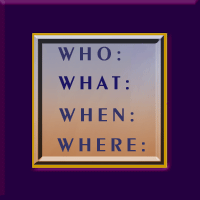
EFFECTIVE INTERVIEW PREPARATION
The Art and Science of Writing
Today’s post is a recipe to help you prepare for any general or oral history interview you may conduct. While the ingredients may prove dry for some of my readers, my intent is to simplify the process for those of you seeking to broaden your skills as a researcher, interviewer and writer. For, like a piece of fine art, the strong interview provides a complex layering of elements that leads to a deeper understanding of the interviewee’s life, their place within world events, and the experiences that have made them who they are.
Relying on their charm and a heavy dose of luck, some interviewers claim that establishing a good rapport with one’s subject is all that is required for a strong interview. But although creating a personal connection with your subject is definitely required, I urge you to consider that doing a bit of research will strengthen your credibility with the interviewee and boost your skills as a professional interviewer worthy of respect.
Although the following example falls under the category of art, it demonstrates how the lack of professional training can interfere with one’s work. Many years ago, I met a gifted painter who employed the tiniest makeup brushes to create delicate lace, fine hairs on African wildlife, and complex patterns on silken fabrics. Noticing flaws in the placement of shadows, proportion of objects, and the musculature of human bodies, I gently suggested she take classes in the foundations of art.
When she responded that an art teacher had previously crushed her spirit, I suggested she study privately with an artist she could carefully select for compatibility. Over the years she has achieved a measure of success, but the flaws I first noticed continue throughout the body of her work. I can only imagine what the knowledge of an authoritative artist could have added to the depth of her art.
Where should you begin your research as an interviewer? Like the ideal scientist, you will want to thoroughly research your interview subject, confirming basic facts you may have assumed were correct. To establish a reliable foundation for the facts to be revealed in the interview (as well as to offer a concise expression of the interviewee’s viewpoint), you will need to conduct research that goes beyond the details of their résumé. This work should be completed before formulating the questions you will ask in the interview.
As you move through the process of gathering information, consider the following questions. What is the purpose of the interview project? What are the demographics of your target audience who will be accessing your work? Also, what direction is suggested by the format and themes of the media outlet with which you are working?
Regardless of the proposed thrust of an interview, information that the public may seek about the subject should be addressed. In addition, if you wish to separate your interview from others the subject may have granted, I believe it is good to have at least one surprising fact revealed.
Now comes what some will consider the boring work. There’s no way around it, unless you want to rely on your great charm. To organize the facts you have discovered effectively, I suggest you consider using several tools.
- Create a double-spaced copy of the interviewee’s résumé or curriculum vitae [CV]. Highlight each piece of information you need to verify. Place a check mark beside each one you confirm.
- Working from either a list provided by the subject (or revealed in your research), examine the interviewee’s articles, books, previous interviews, and other expressions of their thoughts that may exist.
- As you proceed with your research, write out potential topics for your forthcoming dialogue.
- Create a timeline of the subject’s life. Although you may be focused on their career and public persona, list highlights in both their professional and personal living as a guideline to help you respond to unexpected turns your dialogue may take. Depending on what has made the person newsworthy, you may wish to look at a graph of historical events that intersect with their life.
How will such timelines be useful? If, for example, the interviewee was involved in the labor movement of the post-World War II era, the strikes of labor unions on the West Coast and in Hawai`i greatly impacted the general public as well as union members. Consider also the arts. If your subject is a composer of music or lyrics, you may find that their noteworthy pieces were created at times of considerable importance in history. Sometimes their work will actually be named for such an occurrence or an entire era. This was true of a symphony named for, and embodying the discordant notes of, the Chinese Cultural Revolution. Depending on the flow of your interview, reference to an intersection of general history and your subject’s life may yield surprising insights about their career or personal living. This can help you communicate with your subject, as well as with your readers or listeners.
- Prepare an interviewee survey. Sequence your questions from the information they have provided to you. You can simplify the process for your subject by filling in information you have been able to confirm through your research. This could include: Dates and descriptions of their degrees, certifications, accreditations, and other qualifications; institutions of affiliation; professional positions they have held; published works, community volunteerism and other involvement; names, ages, careers of spouse, partners, or children. Remember that if you put in data you have not confirmed, you may be inviting errors—should their memory be flawed, or they actually wish to perpetuate dissemination of erroneous information.
To further your acquaintanceship—and to trigger your subject’s memories—you may want to offer blank space for them to fill in items such as: Their nicknames; mentors and public figures who have impacted their life; programs and schools of thought that have shaped their perspective; adjunct and social organizations with which they may be associated; and, hobbies and interests. Whether or not you wish to pursue topics such as political, philosophical or religious associations may depend on both what you have learned about your interviewee and the orientation of the media outlet with which you are working.
Despite the details I am suggesting you consider, keep the resulting survey as short and simple as possible. I also recommend using a five-point Likert Scale for any questions you wish answered with a measurement of the subject’s agreement. Hopefully, your subject will be able to provide you with a completed survey prior to the interview. This will allow you to fold their responses into questions you are preparing for conducting the interview.
If you do not receive a response to your survey, have a pleasant conversation with your interviewee about your preparation, so that they will want to participate fully in the process. If necessary, try to reschedule the survey by a day or two to ensure you are fully prepared. If you must conduct the interview without seeing your subject’s survey responses, you may want to take a few moments to try to write notes in the margins of your interview questions about issues you now feel you need to explore.
By the time you are nearing completion of your research, you should know whether or not the facts you have uncovered demonstrate your subject’s ability and desire to answer your questions fully and honestly. In addition, you will have determined whether the facts revealed are in accord with the original goals of your project. It is also important to determine whether the direction of the interview indeed fits within the thrust of the media outlet with which you may be working.
It is possible that you will find there are fundamental conflicts within the facts revealed in your research, your initial perspective on the interviewee, and the boundaries of the planned interview. If you are able to control publication of the information resulting from your interview, you are fortunate. But if you are restricted by the media outlet’s direction, I sincerely hope you will discuss your concerns with their management team prior to conducting an interview that does not honor you or your interviewee.
Wishing you the best in your creative endeavors,
Jeanne Burrows-Johnson, author, consultant, and motivational speaker
For further information on interviews and oral histories, see:
Overview of Interview and Oral History Projects, June 2015
Researching for Interviews, July 2015
Conducting Interviews, May 2016
After the Interview, August 2017
To learn more about the award-winning Natalie Seachrist Hawaiian Mysteries, including Murders of Conveyance [Winner, Fiction Adventure-Drama, 2019 New Mexico-Arizona Book Awards] and other projects, please drop in at my author’s website JeanneBurrows-Johnson.com. You’ll even find Island Recipes that might inspire your culinary creativity.
For more ideas to strengthen your Wordpower© and branding, please visit: Imaginings Wordpower and Design Consultation.
Follow Me On:
Amazon, Arizona Authors Association, Apple Books,
Audible, Authors Den, Barnes and Noble, Blogarama, Book Bub,
Cozy Mysteries-Unlimited, Facebook, Good Reads, Hometown Reads
Book sellers may contact book distributors such as:
Baker & Taylor, Follett, IPG, Ingram, Mackin, Midpoint, TitleWave


